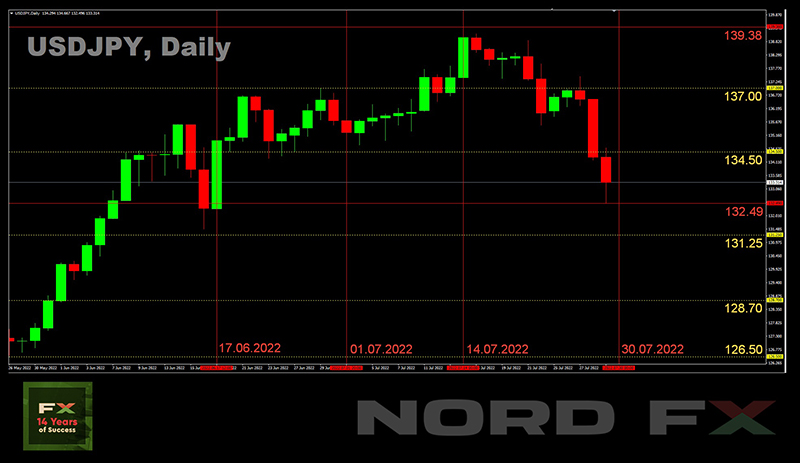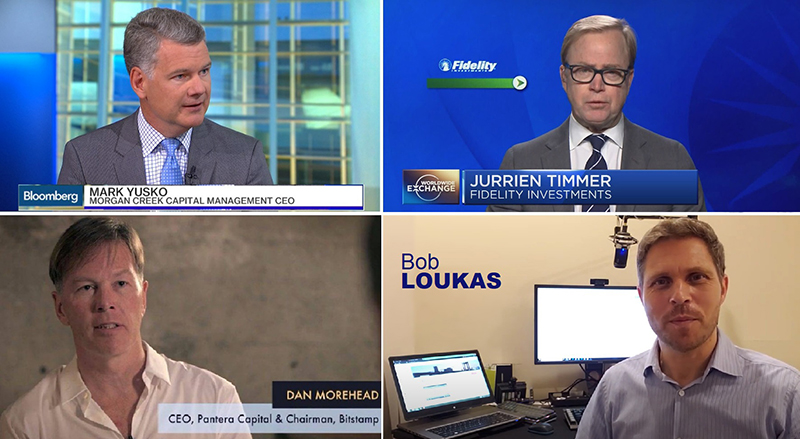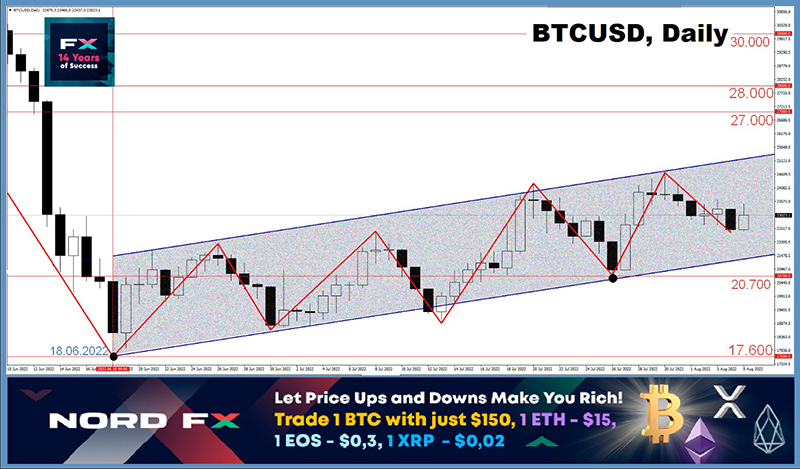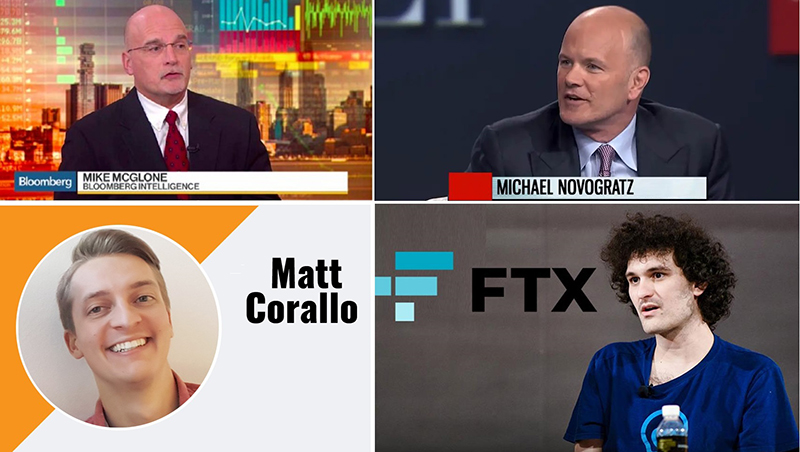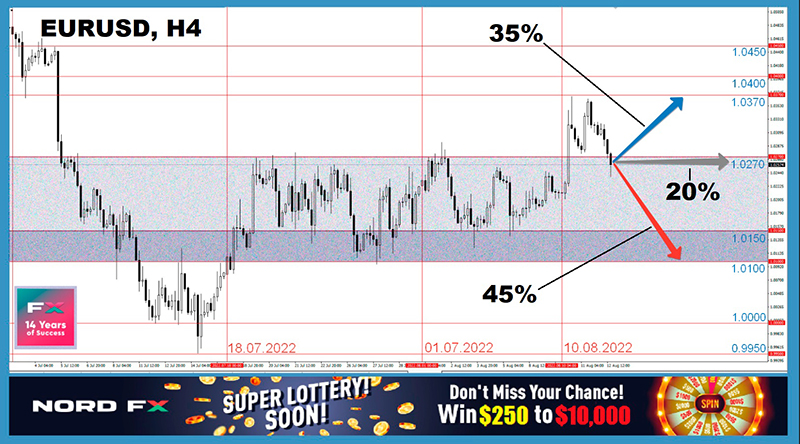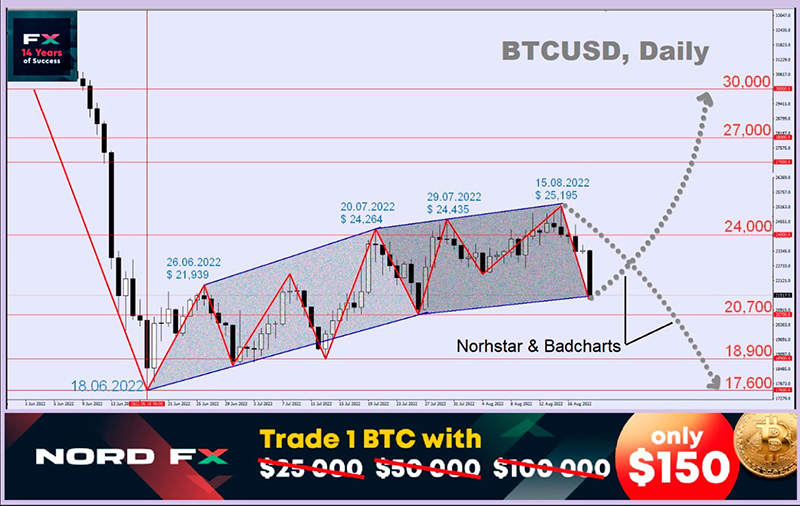Stan NordFX
NordFX Representative
- Messages
- 711
Forex and Cryptocurrencies Forecast for July 25 - 29, 2022
EUR/USD: The ECB's Monetary Experiment: Crossing a Hawk with a Dove
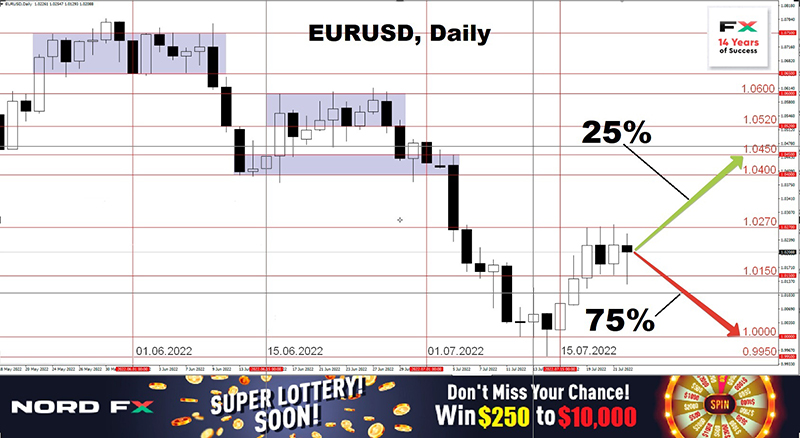
The single European currency showed slight growth at the beginning of last week, fixing a local high at 1.0272. There are three reasons for this. The first and most banal one is a corrective rebound after the EUR/USD pair, having broken through the parity level of 1.0000, found the bottom at 0.9951 on July 14. The second one is the resumption of Russian gas supplies to the EU via the Nord Stream pipeline. And finally, the third and most important one is the expectation of a rise in the euro interest rate. Moreover, the market expected that the rate would be raised by 50 basis points (bp) at once, and not by 25, as announced by the ECB itself at its previous meeting. This is what happened in reality. For the first time in 13 years, the European regulator raised the lending rate from 0 to 0.5% on Thursday, July 21, and brought the deposit rate out of the negative zone, raising it from -0.5% to 0%.
The ECB explained in its press release that it felt appropriate to take a larger first step towards rate normalization for two reasons. The first is obvious and consists of an updated assessment of inflation growth. As a second reason, the ECB announced the launch of a new instrument, the Transmission Protection Instrument (TPI), which should allow, despite the increase in the rate, not to increase the cost of borrowing too aggressively in the vulnerable economies of the Eurozone. The TPI description explains that this tool was introduced to counter the unreasonable erratic market movements that took place in mid-June.
In short, the essence of TPI is that the ECB will be able to buy back securities issued in those EU countries where there is a destabilization of financial conditions unjustified by fundamental factors, on the secondary market. The volume of purchases is not limited by anything and will depend on the severity of the risks. In other words, the regulator will try to cross a hawk with a dove: on the one hand, by raising the rate (QT), and on the other hand, by continuing potentially unlimited quantitative easing (QE). The market reaction to this monetary experiment turned out to be appropriate and predictable: the EUR/USD pair fell to 1.0152. After that, it went up again and completed the five-day period at the level of 1.0210.
There will be a meeting of the FOMC (Federal Open Market Committee) of the US Federal Reserve next week, on Wednesday, July 27. Almost no one doubts that the key interest rate will be raised there. But how much? By 100 bp, which hasn't happened since 1981, or by 75 bp? If the FOMC chooses the first option, the rate will reach 2.75%. It is this growth that the markets put into their quotes, expecting a new assault on the 1.0000 horizon by the EUR/USD pair. However, if the Fed abandons this idea and the rise is more modest, then a further rebound of the pair to the north is not ruled out.
At the time of writing this review, on the evening of July 22, 25% of experts supported the growth of the pair. The remaining 75% showed it the way to the south. The oscillator readings on D1 give a slightly different signal: 60% are colored red, 25% are green and 15% are neutral grey. As for the trend indicators, 65% look south, the remaining 35% have taken the opposite position. The immediate support for the EUR/USD pair is the 1.0150-1.0200 zone, then, of course, comes the 1.0000 level. After it is broken, the bears will target the July 14 low at 0.9950, even lower is the strong 2002 support/resistance zone. 0.9900-0.9930. The next serious task for the bulls will be to break through the resistance at 1.0270 and return to the 1.0400-1.0450 zone, followed by the 1.0520-1.0600 and 1.0650-1.0750 zones.
As already mentioned, the most important event of the upcoming week will be the FOMC meeting of the US Federal Reserve and its decision on the interest rate. The volume of US orders for capital goods and durable goods will become known on the same day, Wednesday, July 27. Data (CPI) on consumer markets in Germany and the Eurozone will arrive on Thursday, July 28 and Friday, July 29, respectively. The preliminary size of the US GDP (Q2) will be known on July 28, and the GDP of Germany and the Eurozone on July 29.
GBP/USD: The Battle for 1.2000 Continues
Last week was quite busy for the pound as for the publication of important macro-statistics on the UK. And although it turned out to be rather ambiguous, there were distinct positive notes in it, especially where it concerned the labor market. The number of applications for unemployment benefits in the country for the month decreased from 34.7K to 20.0K, and this is against the forecast of 41.2K.
Unlike EUR/USD, thanks to such statistics, the GBP/USD pair showed more confident growth and managed to return to where it was trading two and five weeks ago, putting the final chord at around 1.2000. And now the question arises: will this level turn into strong resistance or support?
At the moment, 75% of experts believe that the British currency will continue to lose ground, 25%, on the contrary, expect a rebound upwards. The readings of the indicators on D1 are as follows. Among the trend indicators, the balance of power is 65-35% in favor of the reds. Among the oscillators, the advantage of the bears is much less: 35% indicate a fall, 25% indicate an increase, the remaining 40% remain neutral. The closest support is located in the 1.1875-1.1915 zone. Below is the level of 1.1800, the low of July 14 of 1.1759, then 1.1650, 1.1535 and the lows of March 2020 in the zone 1.1400-1.1450. As for the bulls, they will meet resistance in the zones and at the levels of 1.2100, 1.2160-1.2175, 1.2200-1.2235, 1.2300-1.2325 and 1.2400-1.2430.
The macroeconomic calendar does not include major news from the United Kingdom itself. The determining factor for the dynamics of the GBP/USD pair, of course, will be the meeting of the US Federal Reserve on Wednesday, July 27. Recall that the interest rate on the pound is 1.25% at the moment , and the next meeting of the Bank of England (BOE) is scheduled for August 04, 2022.
USD/JPY: Correction or Trend Change?
What most experts dreamed about for so long has come true. The USD/JPY pair did not renew the 24-year high again, and did not even take a break, but literally collapsed down. And this despite the fact that the Bank of Japan (BOJ) once again left the interest rate unchanged at a negative level of -0.1% on Thursday, July 21. The management of the regulator did not even hint of tightening monetary policy. On the contrary, it was stated that the Japanese Central Bank will not hesitate to take additional easing measures (QE) if necessary, and also expects short-term and long-term interest rates to remain at the current or even lower (!) levels.
Although inflation in Japan tends to rise, it is still below 2%, which is many times lower than in the US and Europe. Thus, given the dynamics of domestic demand and weak wage growth, there is still little incentive for the BOJ to change its ultra-dove tack. So the current strengthening of the yen and the fall of the pair USD/JPY from 139.38 to 135.56 is due, with a high degree of probability, to its being strong overbought.
This time, 70% of experts are waiting for a new push of the pair to the height of 142.00. 15% hope for a continuation of the downtrend, the remaining 15% speak of a side corridor. The picture is vaguer in the readings of indicators on D1: trend indicators have a parity of 50% to 50%, 25% of oscillators look to the north, 40% to the south and 35% to the east. Supports are located at the levels and in the zones 135.55, 134.75, 134.00, 133.50, 133.00 and 131.40. Resistances are 136.35-137.00, 137.90-138.40, 138.50-1.139.00, followed by the July 14 high at 139.38 and round bull targets of 140.00 and 142.00.
No major events are expected in Japan this week. Of course, we can note the publication on Monday, July 26 of the report on the latest meeting of the Monetary Policy Committee of the Bank of Japan, however, it is unlikely that it will cause not only a tsunami, but even a small wave in the market. So the focus of attention, as for other currency pairs, will be on the meeting of the US Federal Reserve on Wednesday, July 27.
CRYPTOCURRENCIES: A Little Patience, Ladies and Gentlemen!
For the first time since June 13, BTC/USD rose above $23,000 and even hit $24,263 last week. What is this, a long-awaited change in trend? Or a brief thaw in the middle of a crypto winter? Or maybe another insidious trap arranged by bears for gullible investors? Let's figure it out.
We have repeatedly written that a popular marker among crypto-analysts is the 200-week moving average (SMA200), which has been referred to more and more often lately. The reason is that it used to be the main support for the BTC/USD pair. But it is not at all certain that what happened before will be repeated in the future. And the proof of this is the recent breakdown of this very SMA200. However, this technical analysis indicator is still one of the most used in making forecasts.
So, bitcoin managed to rise above the 200-week moving average last week. The reason for this, of course, is not that the flagship cryptocurrency has become stronger, but that the US dollar has weakened a little. Against this background, the US stock indices, S&P500, Dow Jones and Nasdaq went up, and after them the quotes of such risky assets as cryptocurrencies followed.
At the time of writing this review (Friday evening, July 22), bitcoin is trading around $22,670. The total capitalization of the crypto market is $1.026 trillion ($0.945 trillion a week ago). The Crypto Fear & Greed Index rose from 15 to 33 points in a week, and finally got out of the Extreme Fear zone into the Fear zone.
Thus, bitcoin is up about 20% from the July 13 low ($18.886) and is just above the 200-week moving average ($22.565). According to analysts at the Binance crypto exchange, such a close of the week gives hope for the restoration of strong support in the form of SMA200, which is typical for bitcoin bear cycles.
Bitcoin’s break above the 200-week SMA caused a surge of enthusiasm among investors. Amsterdam Stock Exchange trader Michael van de Poppe first tweeted out a graphical forecast anticipating a cryptocurrency rally to $28,000 and then compared the current market situation to the recovery from the memorable collapse triggered by the announcement of the coronavirus pandemic in March 2020. At that time, bitcoin collapsed to $3,782, but then rose by 1.600% over the next 13 months (to $64,853 in April 2021).
Analysts of the Kraken cryptocurrency exchange are equally optimistic, who also use the 200-week moving average as the main indicator. In particular, they drew attention to the multipliers with which BTC traded in the past relative to its 200-week SMA. Thus, having rebounded from the SMA200, bitcoin grew 15.2 times in December 2017. The growth was 13.2 times in November 2013. At the moment, BTC is trading close to its 200-week moving average. If the coin shows a multiplier in the range of 13x - 15x again, it may rise to about $300,000.
Of course, the multiplier for BTC was not always 10x when touching the SMA200. Growth peaked at 5.8x in March 2021 before the crypto market began to decline noticeably. However, even with this value of the multiplier, bitcoin can rise to $130,000. But when will this happen? The patience of many market participants has already run out.
We have already written that, according to Glassnode data, bitcoin's record price decline in June almost took the rest of the “market tourists” out of the game, leaving only hodlers “at the front”. In the context of monthly dynamics, the situation was worse only in 2011. The largest outflow was recorded among institutional investors (companies with investments from $1 million), public miners (expanding production on credit), as well as speculators and casual players.
Assuming the market cycle repeats, the bearish phase of bitcoin will end in the first half of autumn. Such a conclusion can be drawn from the historical data provided by the analysts at Grayscale Investments. It took bitcoin 1,290 and 1,257 days to form a full cycle in 2012 and 2016, respectively. It took 391 and 364 days to fall from the peak by 73% in 2012 and by 84% in 2016. The duration of the current cycle, which began in 2020, has reached 1206 days (as of July 20, 2022). In other words, it may take another two to three months before reaching the bottom.
A crypto strategist with the nickname Rekt Capital came to similar conclusions. In his opinion, despite the oversold signals, the downward exchange rate movement may continue for quite a long time. The analyst noted that the Relative Strength Index (RSI) on the BTC monthly timeframe is now below the lowest levels of the bear markets of 2015 and 2018, which could become new resistance levels for bitcoin.
According to Rekt Capital, the short-term prospects of the coin do not look very good, and the bottom can be reached only in a few months: “Bitcoin has about 650 days before the next halving (April 2024). Historically, it bottomed around 517-547 days before its halving. In the event of a repeat of history, bitcoin will need another 100-150 days before reaching the bottom, which will form in the fourth quarter of 2022.”
American businessman Thomas Peterffy, whose capital is estimated at $18.4 billion, is ready to buy bitcoins when the value of the cryptocurrency drops to $12,000. This chairman of Interactive Brokers admitted in a recent interview with Forbes that he does not intend to buy cryptocurrency at the current, in his opinion, high price, as he believes that in the future, bitcoin is very likely to depreciate or be banned in the United States.
Most traders from China are in solidarity with Thomas Peterffi. A poll on the social network Weibo with the participation of more than 2,200 people showed that Chinese traders are waiting for further decline in the price of bitcoin. 8% of respondents said they would buy BTC at $18,000 per coin. 26% of respondents will start purchases at $15,000. But if the bitcoin rate falls to $10,000, 40% of respondents will buy the first cryptocurrency.
It can be seen from all of the above that, despite the prospects for BTC to rise to the cosmic $300,000, there are no clear signals for investing in this coin yet. The US Federal Reserve will make a decision on the interest rate on Wednesday, July 27. And, most likely, the prospects for the BTC/USD pair will become more distinct after that. A sharp increase in the rate will lead to an increase in the DXY dollar index and a further drop in investor risk appetite. And then the chances of seeing bitcoin at $10,000 will increase dramatically. Otherwise, we'll see it aim for $30,000. It won't take long to find out which of these scenarios will come true. So, dear traders and investors, let's be patient.
NordFX Analytical Group
Notice: These materials should not be deemed a recommendation for investment or guidance for working on financial markets: they are for informative purposes only. Trading on financial markets is risky and can lead to a loss of money deposited.
#eurusd #gbpusd #usdjpy #btcusd #ethusd #ltcusd #xrpusd #forex #forex_example #signals #cryptocurrencies #bitcoin #stock_market
https://nordfx.com/

